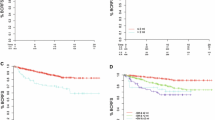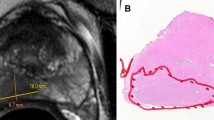Abstract
Purpose
The prognostic value of tumor volume in predicting biochemical recurrence after prostatectomy has been debated. Our aim in this study was to (a) evaluate tumor volume as an independent predictor of adverse pathologic outcomes and BCR and (b) determine the effect of two different methods of tumor volume estimation.
Methods
We reviewed the charts of 3,087 patients who underwent radical prostatectomy at Vanderbilt University Medical Center between 2000 and 2008; of which 1,747 patients had data sufficient for analysis. Prostate specimens were processed as whole mount between 2000 and 2003 and then via systematic sampling from 2003 to 2008, with tumor volume measured by planimetry in the whole-mount group and tumor volume estimated by percent tumor involvement in the systematic sampling group.
Results
Tumor volume estimates were higher with SS than with WM. There were significant associations between larger tumor volume and adverse pathological outcomes, regardless of pathologic method (all with P < 0.001). Controlling for other pathologic parameters, tumor volume was an independent predictor of PGS, EPE, and SM in logistic regression models (P < 0.001 for TV in all models). Tumor volume was demonstrated to be an independent predictor of BCR in the WM group (1.06, 95% CI 1.01–1.11, P = 0.013), though tumor volume was not a significant predictor of BCR in the SS group.
Conclusions
Though the prognostic value of tumor volume is debated, our data demonstrate that tumor volume, when calculated via planimetry on whole-mount pathologic sectioning, is a significant predictor of biochemical recurrence after prostatectomy.


Similar content being viewed by others
Abbreviations
- TV:
-
Tumor volume
- SS:
-
Systematic sampling
- WM:
-
Whole mount
- PGS:
-
Pathologic gleason score
- EPE:
-
Extraprostatic extension
- SM:
-
Positive surgical margin
- LNI:
-
Lymph node involvement
- SVI:
-
Seminal vesicle invasion
- PTI:
-
Percent tumor involvement
- BCR:
-
Biochemical recurrence
- RALP:
-
Robotic assisted laparoscopic prostatectomy
- RRP:
-
Retropubic radical prostatecomy
References
Jemal A, Siegel R, Ward E, Hao Y, Xu J, Thun MJ (2009) Cancer statistics, 2009. CA: a cancer journal for clinicians 59(4):225–249. doi:10.3322/caac.20006
Bill-Axelson A, Holmberg L, Ruutu M, Häggman M, Andersson SO, Bratell S, Spångberg A, Busch C, Nordling S, Garmo H, Palmgren J, Adami HO, Norlén BJ, Johansson JE, 4 SPCGSN (2005) Radical prostatectomy versus watchful waiting in early prostate cancer. N Engl J Med 352(19):1977–1984. doi:10.1056/NEJMoa043739
Porter CR, Kodama K, Gibbons RP, Correa R Jr, Chun FK, Perrotte P, Karakiewicz PI (2006) 25-year prostate cancer control and survival outcomes: A 40-year radical prostatectomy single institution series. J Urol 176(2):569–574. doi:10.1016/j.juro.2006.03.094
Bolla M, Vanpoppel H, Collette L, Vancangh P, Vekemans K, Dapozzo L, Dereijke T, Verbaeys A, Bosset J, Vanvelthoven R (2005) Postoperative radiotherapy after radical prostatectomy: A randomised controlled trial (eortc trial 22911). Lancet 366(9485):572–578. doi:10.1016/S0140-6736(05)67101-2
Roehl KA, Han M, Ramos CG, Antenor JA, Catalona WJ (2004) Cancer progression and survival rates following anatomical radical retropubic prostatectomy in 3, 478 consecutive patients: long-term results. J Urol 172(3):910–914. doi:10.1097/01.ju.0000134888.22332.bb
Stamey TA, McNeal JE, Yemoto CM, Sigal BM, Johnstone IM (1999) Biological determinants of cancer progression in men with prostate cancer. JAMA 281(15):1395–1400
Kattan MW, Wheeler TM, Scardino PT (1999) Postoperative nomogram for disease recurrence after radical prostatectomy for prostate cancer. J Clin Oncol 17(5):1499–1507
Merrill MM, Lane BR, Reuther AM, Zhou M, Magi-Galluzzi C, Klein EA (2007) Tumor volume does not predict for biochemical recurrence after radical prostatectomy in patients with surgical gleason score 6 or less prostate cancer. Urology 70(2):294–298. doi:10.1016/j.urology.2007.03.062
Guzzo TJ, Vira MA, Neway W, Hwang WT, Tomaszewski J, VanArsdalen K, Wein AJ, Malkowicz SB (2007) Minimal tumor volume may provide additional prognostic information in good performance patients after radical prostatectomy. Urology 69(6):1147–1151. doi:10.1016/j.urology.2007.02.005
Chun FK, Briganti A, Jeldres C, Gallina A, Erbersdobler A, Schlomm T, Walz J, Eichelberg C, Salomon G, Haese A, Currlin E, Ahyai SA, Benard F, Huland H, Graefen M, Karakiewicz PI (2007) Tumour volume and high grade tumour volume are the best predictors of pathologic stage and biochemical recurrence after radical prostatectomy. Eur J Cancer 43(3):536–543. doi:10.1016/j.ejca.2006.10.018
Rampersaud EN, Sun L, Moul JW, Madden J, Freedland SJ (2008) Percent tumor involvement and risk of biochemical progression after radical prostatectomy. J Urol 180(2):571–576, discussion 576. doi: 10.1016/j.juro.2008.04.017
Kikuchi E, Scardino PT, Wheeler TM, Slawin KM, Ohori M (2004) Is tumor volume an independent prognostic factor in clinically localized prostate cancer? J Urol 172(2):508–511. doi:10.1097/01.ju.0000130481.04082.1a
Salomon L, Levrel O, Anastasiadis AG, Irani J, De La Taille A, Saint F, Vordos D, Cicco A, Hoznek A, Chopin D, Abbou CC (2003) Prognostic significance of tumor volume after radical prostatectomy: a multivariate analysis of pathological prognostic factors. Eur Urol 43(1):39–44
Nelson B, Shappell S, Chang SS, Wells N, Farnham S, Smith JA, Cookson M (2006) Tumour volume is an independent predictor of prostate-specific antigen recurrence in patients undergoing radical prostatectomy for clinically localized prostate cancer. BJU Int 97(6):1169–1172. doi:10.1111/bju.2006.97.issue-6
Jack GS, Cookson MS, Coffey CS, Vader V, Roberts RL, Chang SS, Smith JA Jr, Shappell SB (2002) Pathological parameters of radical prostatectomy for clinical stages t1c versus t2 prostate adenocarcinoma: decreased pathological stage and increased detection of transition zone tumors. J Urol 168(2):519–524
Srigley JR (2006) Key issues in handling and reporting radical prostatectomy specimens. Arch Pathol Lab Med 130(3):303–317
Cookson MS, Aus G, Burnett AL, Canby-Hagino ED, D’Amico AV, Dmochowski RR, Eton DT, Forman JD, Goldenberg SL, Hernandez J, Higano CS, Kraus SR, Moul JW, Tangen C, Thrasher JB, Thompson I (2007) Variation in the definition of biochemical recurrence in patients treated for localized prostate cancer: the American urological association prostate guidelines for localized prostate cancer update panel report and recommendations for a standard in the reporting of surgical outcomes. J Urol 177(2):540–545. doi:10.1016/j.juro.2006.10.097
Porten SP, Cooperberg MR, Carroll PR (2010) The independent value of tumour volume in a contemporary cohort of men treated with radical prostatectomy for clinically localized disease. BJU Int 105(4):472–475. doi: 10.1111/j.1464-410X.2009.08774.x
Sherwin JC, Mirmilstein G, Pedersen J, Lawrentschuk N, Bolton D, Mills J (2010) Tumor volume in radical prostatectomy specimens assessed by digital image analysis software correlates with other prognostic factors. J Urol 183(5):1814, discussion 1815. doi: 10.1016/j.juro.2010.01.017
Epstein JI, Carmichael M, Partin AW, Walsh PC (1993) Is tumor volume an independent predictor of progression following radical prostatectomy? A multivariate analysis of 185 clinical stage b adenocarcinomas of the prostate with 5 years of followup. J Urol 149(6):1478–1481
Uhlman M, Sun L, Stackhouse D, Polascik T, Mouraviev V, Robertson C, Albala D, Moul JW (2010) Tumor percent involvement predicts prostate specific antigen recurrence after radical prostatectomy only in men with smaller prostate. J Urol 183(3):997–1002. doi:10.1016/j.juro.2009.11.046
Zhou J, Schmid T, Schnitzer S, Brune B (2006) Tumor hypoxia and cancer progression. Cancer Lett 237(1):10–21. doi:10.1016/j.canlet.2005.05.028
Conflict of interest
No author or contributor to this paper has any conflict of interest to disclose related to this research project or the sponsorship thereof.
Author information
Authors and Affiliations
Corresponding author
Rights and permissions
About this article
Cite this article
Thompson, I.M., Salem, S., Chang, S.S. et al. Tumor volume as a predictor of adverse pathologic features and biochemical recurrence (BCR) in radical prostatectomy specimens: A tale of two methods. World J Urol 29, 15–20 (2011). https://doi.org/10.1007/s00345-010-0611-x
Received:
Accepted:
Published:
Issue Date:
DOI: https://doi.org/10.1007/s00345-010-0611-x




